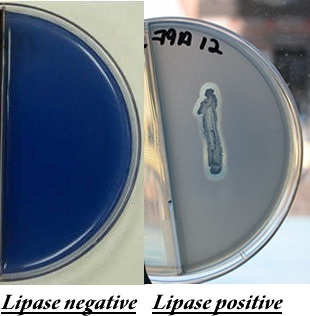 Simmon’s Citrate Agar
Simmon’s Citrate Agar
This is a defined medium used to determine if an organism can
use citrate as its sole carbon source. It is often used to differentiate
between members of Enterobacteriaceae. In organisms capable
of utilizing citrate as a carbon source, the enzyme citrase hydrolyzes
citrate into oxaoloacetic acid and acetic acid. The oxaloacetic
acid is then hydrolyzed into pyruvic acid and CO2.
If CO2 is produced, it reacts with components
of the medium to produce an alkaline compound (e.g. Na2CO3).
The alkaline pH turns the pH indicator (bromthymol blue) from
green to blue. This is a positive result (the tube on the right
is citrate positive). Klebsiella pneumoniae and Proteus
mirabilis are examples of citrate positive organisms. Escherichia coli and Shigella dysenteriae are citrate
negative.
Spirit Blue agar
This agar is used to identify organisms that are capable of producing
the enzyme lipase. This enzyme is secreted and hydrolyzes triglycerides
to glycerol and three long chain fatty acids. These compounds are
small enough to pass through the bacterial cell wall. Glycerol can
be converted into a glycolysis intermediate. The fatty acids can be
catabolized and their fragments can eventually enter the Kreb’s
cycle. Spirit blue agar contains an emulsion of olive oil and spirit
blue dye. Bacteria that produce lipase will hydrolyze the olive oil
and produce a halo around the bacterial growth. The Gram-positive
rod, Bacillus subtilis is lipase positive (pictured on the
right) The plate pictured on the left is lipase negative.
 Simmon’s Citrate Agar
Simmon’s Citrate Agar



0 Comments:
Post a Comment